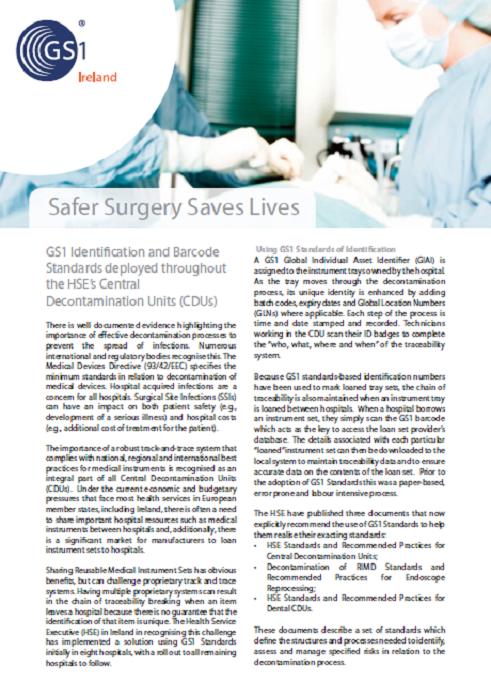The HSE now requires that all surgical instrument trays are identified using GS1 Standards to enable stakeholders to track and trace them throughout the supply chain. The ICT system currently being rolled out is designed to create a collaborative, interoperable, and nationwide traceability solution for Central Decontamination Units. Pauline Biggane is project managing the rollout of this system within the HSE and the following is a paper she has written to explain it all.
Track & Trace
Introduction
Safer Surgery Saves Lives.pdf (size 329.8 KB)
Surgical Instrument Traceability
Safer Surgery Saves Lives - GS1 Identification and Barcode Standards deployed throughout the HSE's Central Decontamination Units (CDUs).
 There is well documented evidence highlighting the importance of effective decontamination processes to prevent the spread of infections. The Medical Devices Directive (93/42/EEC) specifies the minimum standards in relation to decontamination of medical devices. The importance of a robust track-and-trace system that complies with national, regional and international best practices for medical instruments is recognised as an integral part of all Central Decontamination Units (CDUs).
There is well documented evidence highlighting the importance of effective decontamination processes to prevent the spread of infections. The Medical Devices Directive (93/42/EEC) specifies the minimum standards in relation to decontamination of medical devices. The importance of a robust track-and-trace system that complies with national, regional and international best practices for medical instruments is recognised as an integral part of all Central Decontamination Units (CDUs).
Current economic and budgetary pressures mean there is often a need to share important hospital resources such as medical instruments between hospitals and there is also a significant market for manufacturers to loan instrument sets to hospitals. Sharing Reusable Medical Instrument Sets has obvious benefits, but can challenge proprietary track and trace systems.
The Health Service Executive (HSE) in Ireland in recognising this challenge has implemented a solution using GS1 Standards (initially in eight hospitals with a roll out to all remaining hospitals to follow). The attached GS1 case study gives a brief overview of the implementation of GS1 Standards within the surgical instrument use-cycle from theatre to decontamination and back again.
- Ambulance Arrivals Project A Case Study
- SNOMED National Release Centre (NRC)
- SVUH Award winning Patient Flow Whiteboard
- Scan for Surgery
- Hospital-based care
- Digital Natives Sign App
- Digitisation of risk assesment tools for Adult mental health services in north Dublin
- Patient Engagement Operating Systems - Hep C
- Digital Transition for HSCPs at St. James's Hospital
- Primary Care Centre Castlebar Case Study
- Mario - Managing active and healthy ageing using caring service robots
- Claimsure - Health Insurance Claims Management System
- Cyber Attack Response
- Data systems in SVUH Emergency Department
- Electronic Discharge Prescription Pilot
- Epilepsy EPR
- eReferral
- eReferral Radiology Pilot
- eRostering
- Electronic Blood Tracking
- GP Practice Management Systems
- Healthmail
- Heart Failure Virtual Clinic
- Infrastructure - MPUP to ECAM
- IT Security - Small changes, big difference
- Kidney Disease Clinical Patient Management System
- Local Asset Mapping Project at St James' Hospital
- LUCY
- Mi Kidney App
- Model Community
- NCHD - Employment Record Portal
- Nursing & Midwifery Quality Care Metrics
- Ophthalmology Electronic Patient Record
- PharmaBuddy
- Radiology & Electronic Patient Record
- National Smart-Pump Drug Library of Paediatric and Neonatal Standardised Concentration Infusions
- Quality & Patient Safety
- Robotic Assisted Surgery Programme
- Shared Learning on EHR
- St. James' Hospital - National Haemophilia System
- Tallaght Hospital Pharmacy
- Tallaght Hospital Patient Engagement App
- Track & Trace
- Using IT to Improve Ireland's Public Sector Healthcare
- National Audiology Clinical Management System (NA-CMS)
- St Vincent's University Hospital Award Winning Whiteboard Patient Flow System
- Snomed Case Study
- Telehealth Project Donegal
- St Vincent's Whiteboard Patient Journey System a Case Study
- Ambulance Arrivals Project
